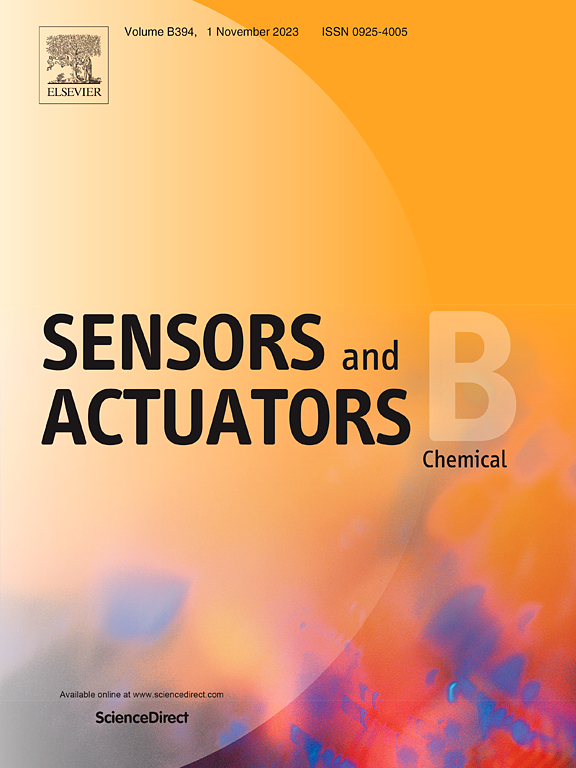Co3O4和Pd的双功能化协同提高了In2O3传感器的感氢性能
IF 3.7
1区 化学
Q1 CHEMISTRY, ANALYTICAL
引用次数: 0
摘要
氢传感器为锂电池热失控的早期预警提供了一种很有前途的技术。然而,还需要进一步的探索来提高它们的气敏性能。本研究采用MIL-68@ZIF-67模板和化学还原法制备了Co3O4十二面体和Pd纳米颗粒包埋的In2O3微管。结果表明,Co3O4十二面体均匀锚定在In2O3微管上,不同含量的Pd纳米粒子被加载到In2O3@Co3O4上,形成In2O3@Co3O4@Pd复合微管。当Pd负载为0.40 wt%时,基于In2O3@Co3O4@Pd的传感器在210 oC和80 oC下对20 ppm H2的响应分别为4.47和2.85,而基于裸露In2O3和In2O3@Co3O4的传感器在这两个温度下均无响应。具有响应时间快(4.5 s)、选择性和重复性好、检测浓度范围宽(0.5~ 1000ppm)等特点。高长径比的一维(1D)微观结构使得In2O3与Co3O4之间存在丰富的紧密连接的n-p异质结,Pd与In2O3@Co3O4之间的强烈相互作用增加了氧空位的含量,共同提高了h2传感性能。所得In2O3@Co3O4@Pd复合材料在实时H2检测中具有很好的应用前景。本文章由计算机程序翻译,如有差异,请以英文原文为准。

Dual functionalization of Co3O4 and Pd synergistically promotes the hydrogen sensing properties of In2O3 sensor
Hydrogen sensors offer a promising technology for inchoate warning of lithium battery thermal runaway. However, further exploration is still needed to enhance their gas-sensing properties. In this study, Co3O4 dodecahedrons and Pd nanoparticles-embedded In2O3 microtubes were synthesized using the MIL-68@ZIF-67 template and chemical reduction method. As a result, Co3O4 dodecahedrons are equably anchored on the In2O3 microtubes, and Pd nanoparticles with different contents are loaded on the In2O3@Co3O4, forming In2O3@Co3O4@Pd composite microtubes. The sensor based on In2O3@Co3O4@Pd with a Pd loading of 0.40 wt% achieves a response of 4.47 and 2.85 toward 20 ppm H2 at 210 oC and 80 oC, respectively, whereas the sensors based on bare In2O3 and In2O3@Co3O4 are unresponsive at these two temperatures. Moreover, fast response time (4.5 s), good selectivity and reproducibility, as well as a wide concentration detection range (0.5~1000 ppm) are also obtained. The one-dimensional (1D) microstructure with a high length-to-diameter ratio affords abundant tightly connected n-p heterojunctions between In2O3 and Co3O4, and the intense interaction between Pd and In2O3@Co3O4 increases the content of oxygen vacancies, which jointly boost the H2-sensing properties. The obtained In2O3@Co3O4@Pd composite has a promising application in real-time H2 detection.
求助全文
通过发布文献求助,成功后即可免费获取论文全文。
去求助
来源期刊

Sensors and Actuators B: Chemical
工程技术-电化学
CiteScore
14.60
自引率
11.90%
发文量
1776
审稿时长
3.2 months
期刊介绍:
Sensors & Actuators, B: Chemical is an international journal focused on the research and development of chemical transducers. It covers chemical sensors and biosensors, chemical actuators, and analytical microsystems. The journal is interdisciplinary, aiming to publish original works showcasing substantial advancements beyond the current state of the art in these fields, with practical applicability to solving meaningful analytical problems. Review articles are accepted by invitation from an Editor of the journal.
 求助内容:
求助内容: 应助结果提醒方式:
应助结果提醒方式:


